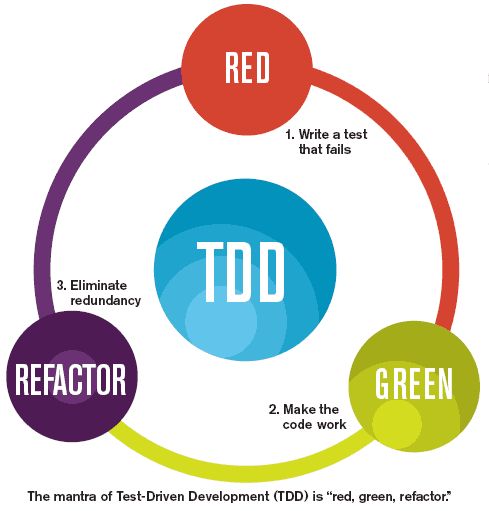Introduction to Test Driven Development(TDD)
A lot of software’s are made these days and building them on a daily basis can be a pricey affair. As well as, much to your surprise, most of the cost is initiated in looking after the software. With so much efforts and strategies gone into making of the software, this becomes annoying. However, with the advent of Test-driven development (TDD) things are looking easy and viable as its main purpose is to help in cutting down of these runaway costs.
This really helps software developers to concentrate in a better way in building the software, enabling them to build higher quality software. Let us delve into the nitty-gritties of test-driven development, a development practice intended at constructing great quality software. In the first place, you will discover the exact meaning of test-driven development. Later on, we will try to find out that why it exists and its importance.
Let us try to understand and decipher Test-driven Development on a broader horizon.
What is Test-driven development?
Test-driven development is an improvement exercise that helps huge maintenance prices, and allows software makers to construct greater quality software. It has become an integral part of software development stages as it has the potential of solving a lot of current and future problems. In the case of automated tests failure, this improvement exercise trains software developers to compose new code, in turn evading duplication of code. Case in point, the most important objective of Test-driven development is to create the code, which is perfect, simple and devoid of bugs.
Enlightenment about the nitty-gritties involved in Test-driven development
First of all, in the Test-Driven Development process, designing and developing test cases for each and every functions of an application gets started. In general, this is the Test-Driven Development process line of attack. The test cases are developed initially insisting on and authenticating what the code will do. As a matter of fact, the codes are generated primarily and then the test cases. Codes are generated prior to the generation of test cases, as tests might miss the mark if they are established even before the development.
To get the best and desired outcomes, the software development team members develop and refactor the code, without affecting the behaviour of the same. Understanding of the steps involved in Test-Driven Development process is the key to get the desired performance of the software. They should be done the way they are explained, the steps given below outline in what way TDD test must be performed.
- Firstly, add a test
- Then all the tests are allowed to run to check for the failure of a new test case.
- And then the codes are generated.
- Again run the available test cases and refactor code.
- Lastly, the steps explained above are repeated.
This can be well understood with the help of a diagram shown below.
Fig 1: Test-driven development approach
It is all about making use of test-driven development by understanding it thoroughly. And then get the knowledge of making software by means of your understanding of test-driven development abilities, and improve the quality of software.
Is test-driven development that important?
Yes, it is important, at least for all the team members involved during the software development process. It allows the developers to take minor strides while writing software. This practice is productive offering benefits as there is a less chance of getting a broken code. Also, it becomes much easier to carry on in smaller and smaller steps making re-compilation and re-running of the exiting test cases simpler and easier. Also, the traditional methods of testing which are used may not be a perfect fit for huge projects. For huge projects, in the real scenario definitely TDD would be required as it works well for huge systems. As a result, we cannot overlook the advantages which TDD has to offer.
On the other hand, to avail the benefits which test-driven development has to offer, it is extremely important for the involved testers and the business people to act as a team. This is suggested to visualize and discuss the software and its consequences prior to the code creation.
Advantages of test-driven development explained
- It definitely allows detecting the bugs too early, if there are any. Though software developers test their code prior to its release, still bugs can arise at any juncture of software development.
- With the help of test-driven development, software developers are able to design the software in a better way with cleaner and more adaptable code.
- It helps to recognize in what way the code will be recycled, resulting in superior software design and more viable code.
- Smaller codes can be written with a solo accountability, allowing the concerned parties to understand it better.
- What is more, test-driven development also powers to write individual code to pass tests centred on consumer necessities.
- Refactoring can be done with ease as proper warning is given if discontinuities are found, which can be fixed prior to the release of the software. This results in a cleaner and clearer code with fewer bugs that can be updated with nominal threats.
- If any team member is not present during the development process, then the new software developers can simply give a lift to the existing code. This knowledge allocation helps the team members to gain a lot of facts, and making the team more operative in doing so.
- It is definitely a boon for software developers as they can spend less time for fixing and developing new features while writing test cases. This helps in making them write cleaner and less complex code.
- Along with writing test cases, interfaces also need to be tested. However, this is not beneficial till you make an effort on a bulk of code where it was not completed. To exercise on a specified part of code it is needed to run the complete system and fix a break-point.
- It boosts trivial strides and mends the design as it makes you amend the needless needs to ease the arrangement.
- It really makes the programmer job easy and simple as they are able to grasp the code really quickly.
- Also, it provides clarity on the requirements as deciphering is needed for an input to be given and on that basis what is the expected output.
The systematic and logical environment of Test-Driven Development confirms much greater attention and high quality code, as the codes are tested, re-tested and fixed. As the tests are conducted from the very start of the software development cycle, period and cash spent in fixing at later phases is reduced. However, there are some disadvantages too. Let’s discuss them one by one.
Disadvantages of test-driven development explained
- To get fruitful results, test-driven development calls for significant expertise, mainly in the initial stages. On the other hand, a lot of systems are not built with unit testing in mind. This makes the separation of components a little difficult.
- In addition to, a lot of software developers lack the expertise to separate and generate fresh code.
- As a matter of fact, every team member needs to generate and keep up the unit tests. This is necessary to keep the tests updated, as, a firm exploring TDD will need to spend time.
- The results of the test-driven development will be good only when methodical test cases are used in tandem with the situations, which are faced by consumers of the end product. It is an advantageous practice and must be adopted by developers. Sometimes extravagant features cause a hurdle in unit testing as simple tests can be created quickly and are easy to manage.
- Generating test cases for fiascos can be monotonous but is it essential as it will offer benefits at the end of the day.
- When refactoring is done initially then the refactoring of test classes also vital.
- Also, each and every team member needs to maintain their test cases to prevent the system from damage.
- Writing test cases need a lot of focus; at times major focus gets shifted to other things resulting in not-so-perfect test cases.
- At the unit level testing, writing test cases is a little daunting.
- It is really tough to work in the same way as you have been working for all these years.
Conclusion
In a nutshell, TDD, in all probability, is the most essential dynamic in the software development process. However, a lot of persistence is required to master TDD. It can be mastered in combinations, wherein one developer writes the tests and the other pens the execution of those test trial cases. After a while, roles can be reversed to get the feel of the task. The productivity and securities offered by TDD are particularly essential for slim start-ups anticipating making it. With a lot of functional benefits, it is definitely an asset for a software firm.
It is definitely transformative for any software development company, as, in the end a test suite is obtained with a cleaner and clearer code. However, it does not guarantee that it offers cent percent test suite. TDD can be the initial idea for well-organized, understandable code that increases proportionally depending on the requirement. For this very reason, it has been adopted by all the agile developers on a wider spectrum.





